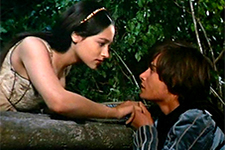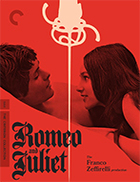Romeo and Juliet
|  It seems so natural and obvious now, but prior to Franco Zefferelli’s 1968 film of Romeo and Juliet, Shakespeare’s “pair of star-cross’d lovers” had been played almost exclusively by adults even though the Bard’s original text makes clear that Romeo is 16 and Juliet is 13. Although filmmakers had taken more than two dozen stabs at adapting the play over the previous seven decades, none had dared to take seriously the stated ages of the titular characters (although, to be fair, neither had most of the directors who staged it theatrically or the artists who painted scenes from it over the previous 370 years). George Cukor’s 1936 film version featured Leslie Howard (43 years old) and Norma Shearer (34 years old), while Renato Castellani’s 1954 version, which won the Golden Lion at the Venice Film Festival, was slightly more accurate with 26-year-old Laurence Harvey and 20-year old Susan Shentall. Zefferelli, however, was much bolder in his casting. Contrary to most Shakespeare adaptations, he cast complete unknowns in the lead roles, which was partially a corrective to the approach he had taken with his first feature, an adaptation of Shakespeare’s The Taming of the Shrew (1966), which featured Richard Burton and Elizabeth Taylor at the height of their stardom/notoriety, which made it more a film about them than anything. This time, Zefferelli went the opposite direction, choosing 17-year-old Leonard Whiting as Romeo and 15-year-old Olivia Hussey as Juliet, who fall in love against the backdrop of an ongoing feud between their respective families. Whiting had had a few small roles on television and in the Disney feature The Legend of Young Dick Turpin (1965); Hussey had similarly landed a few bit parts here and there, most notably in Delmer Davies’s final film, The Battle of the Villa Fiorita (1965). Although largely untested, Whiting and Hussey looked the parts: they were young and attractive and brought natural vibrance and passion to the Bard’s dialogue that made it feel fresh. Zefferelli highlighted the play’s undeniable sexuality, but in a way that emphasizes the purity of first love (all the controversy over the film’s nudity misses its fundamental innocence). Whiting and Hussey have a powerful screen chemistry, and the way they exchange glances, especially when they first spy each other across the dance floor in the film’s most captivating sequence, is electric. Outside of the casting, the approach Zefferelli took to Romeo and Juliet was similar to what he had done with The Taming of the Shrew, including the use of a rich musical score by Nino Rota and shooting on location and in color, the first time anyone had done so with a Shakespeare adaptation since Laurence Olivier’s Henry V (1944). In adapting the play, Zefferelli and his cowriters Franco Brusati and Masolino D’Amico cut about half of the dialogue, but they lost little of the essence of either the characters or the plot. All of the big scenes are largely intact, and the supporting characters are given plenty of room to develop, particularly John McEnery’s Mercutio and Pat Heywood’s Nurse, the latter of whom steals virtually every scene she is in. Zefferelli and cinematographer Pasqualino De Santis, who won an Oscar for his work, give the film a sense of energy that, at the time, was not associated with Shakespeare films, which tended to be arty and staid. Although the film is largely classical in its style, it is enlivened with bursts of handheld camerawork and quick edits, especially in its two memorable fight sequences. Zefferelli recognized that he was making a film about generational conflict at a time when generational conflict was a defining hallmark of the era. As critics then and since have pointed out, Romeo and Juliet, despite having been written in the 1570s, is in many ways the ultimate ’60s tale: Its story of passionate young people struggling to forge their own world of love and connection separate from the one defined by the ages-old conflicts of their elders is a quintessential counterculture fable. Zefferelli was smart enough not to try to cram in any references, however oblique, to the zeitgeist outside the film—this is, after all, still a story told with traditional Italian Renaissance settings and costumes—even as it helped propel Romeo and Juliet to significant commercial success, especially with young viewers who were equally smitten with the violent exploits of the Depression-era outlaws in Bonnie and Clyde (1967). Shakespeare on film would never be the same.
Copyright © 2023 James Kendrick Thoughts? E-mail James Kendrick All images copyright © The Criterion Collection / Paramount Home Entertainment | |||||||||||||||||||||||||||||
Overall Rating: 


 (3.5)
(3.5)


